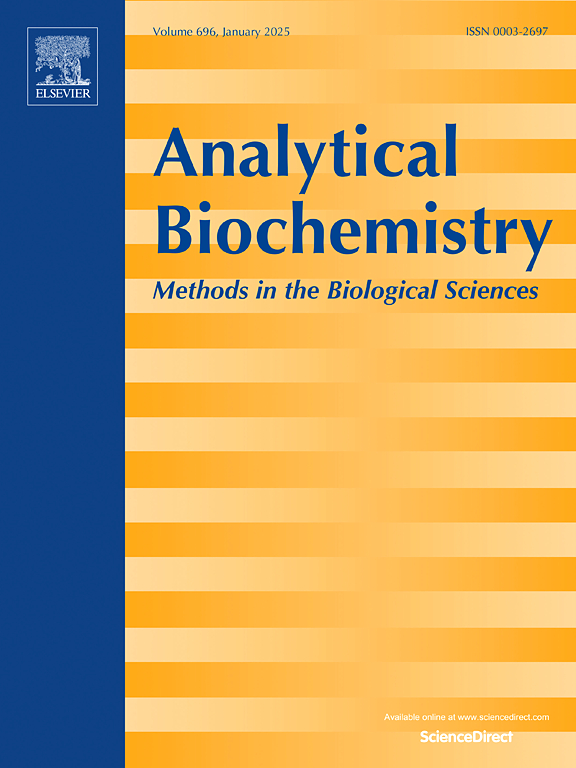In-gel refolding allows fluorescence detection of fully denatured GFPs after SDS-PAGE
IF 2.5
4区 生物学
Q2 BIOCHEMICAL RESEARCH METHODS
引用次数: 0
Abstract
Green fluorescent proteins (GFPs) have been widely used as fusion tags, especially to visualize subcellular localization and dynamics of the fused partner proteins. Also, GFPs serve as fluorescent tags in size-exclusion chromatography and native-PAGE, facilitating the evaluation of expression levels and quality of the expressed fusion proteins. However, the fluorescent detection of GFPs is generally incompatible with denaturing SDS-polyacrylamide gel electrophoresis (PAGE), where the samples are heat-denatured before loading. Accordingly, detecting GFP-fused proteins after SDS-PAGE usually relies on western blotting with anti-GFP antibodies. To enable in-gel fluorescence detection of SDS-PAGE-separated GFPs, some protocols employ mild denaturing conditions to keep the GFPs intact. However, such mild denaturation sometimes results in partial denaturation of the proteins and irregular electrophoretic mobility that is not proportional to their molecular weights. Here, we demonstrate that the fully denatured GFPs can be refolded within the gel by cyclodextrin-mediated removal of SDS in the presence of 20 % methanol, enabling the in-gel fluorescence detection of the GFP-fused proteins. The protocol is compatible with subsequent total protein staining and western blotting. Although future studies are needed to clarify the scope and generality, the technique developed here would provide a simple, time- and cost-effective alternative to the immunodetection of GFPs.

凝胶内再折叠允许在SDS-PAGE后对完全变性的gfp进行荧光检测
绿色荧光蛋白(gfp)已被广泛用作融合标记,特别是用于观察融合伙伴蛋白的亚细胞定位和动态。此外,gfp在大小排斥层析和native-PAGE中作为荧光标记,有助于评估表达的融合蛋白的表达水平和质量。然而,gfp的荧光检测通常与变性sds -聚丙烯酰胺凝胶电泳(PAGE)不相容,后者在加载前对样品进行热变性。因此,SDS-PAGE后检测gfp融合蛋白通常依赖于抗gfp抗体的western blotting。为了能够对sds - page分离的gfp进行凝胶内荧光检测,一些方案采用温和的变性条件来保持gfp的完整。然而,这种轻微的变性有时会导致蛋白质的部分变性和不规则的电泳迁移率,这与它们的分子量不成比例。在这里,我们证明了完全变性的gfp可以在20%甲醇存在的情况下通过环糊精介导的SDS去除在凝胶内重新折叠,从而实现了gfp融合蛋白的凝胶内荧光检测。该方案与随后的总蛋白染色和western blotting兼容。虽然未来的研究需要澄清其范围和普遍性,但这里开发的技术将为gfp的免疫检测提供一种简单,时间和成本效益高的替代方法。
本文章由计算机程序翻译,如有差异,请以英文原文为准。
求助全文
约1分钟内获得全文
求助全文
来源期刊

Analytical biochemistry
生物-分析化学
CiteScore
5.70
自引率
0.00%
发文量
283
审稿时长
44 days
期刊介绍:
The journal''s title Analytical Biochemistry: Methods in the Biological Sciences declares its broad scope: methods for the basic biological sciences that include biochemistry, molecular genetics, cell biology, proteomics, immunology, bioinformatics and wherever the frontiers of research take the field.
The emphasis is on methods from the strictly analytical to the more preparative that would include novel approaches to protein purification as well as improvements in cell and organ culture. The actual techniques are equally inclusive ranging from aptamers to zymology.
The journal has been particularly active in:
-Analytical techniques for biological molecules-
Aptamer selection and utilization-
Biosensors-
Chromatography-
Cloning, sequencing and mutagenesis-
Electrochemical methods-
Electrophoresis-
Enzyme characterization methods-
Immunological approaches-
Mass spectrometry of proteins and nucleic acids-
Metabolomics-
Nano level techniques-
Optical spectroscopy in all its forms.
The journal is reluctant to include most drug and strictly clinical studies as there are more suitable publication platforms for these types of papers.
 求助内容:
求助内容: 应助结果提醒方式:
应助结果提醒方式:


